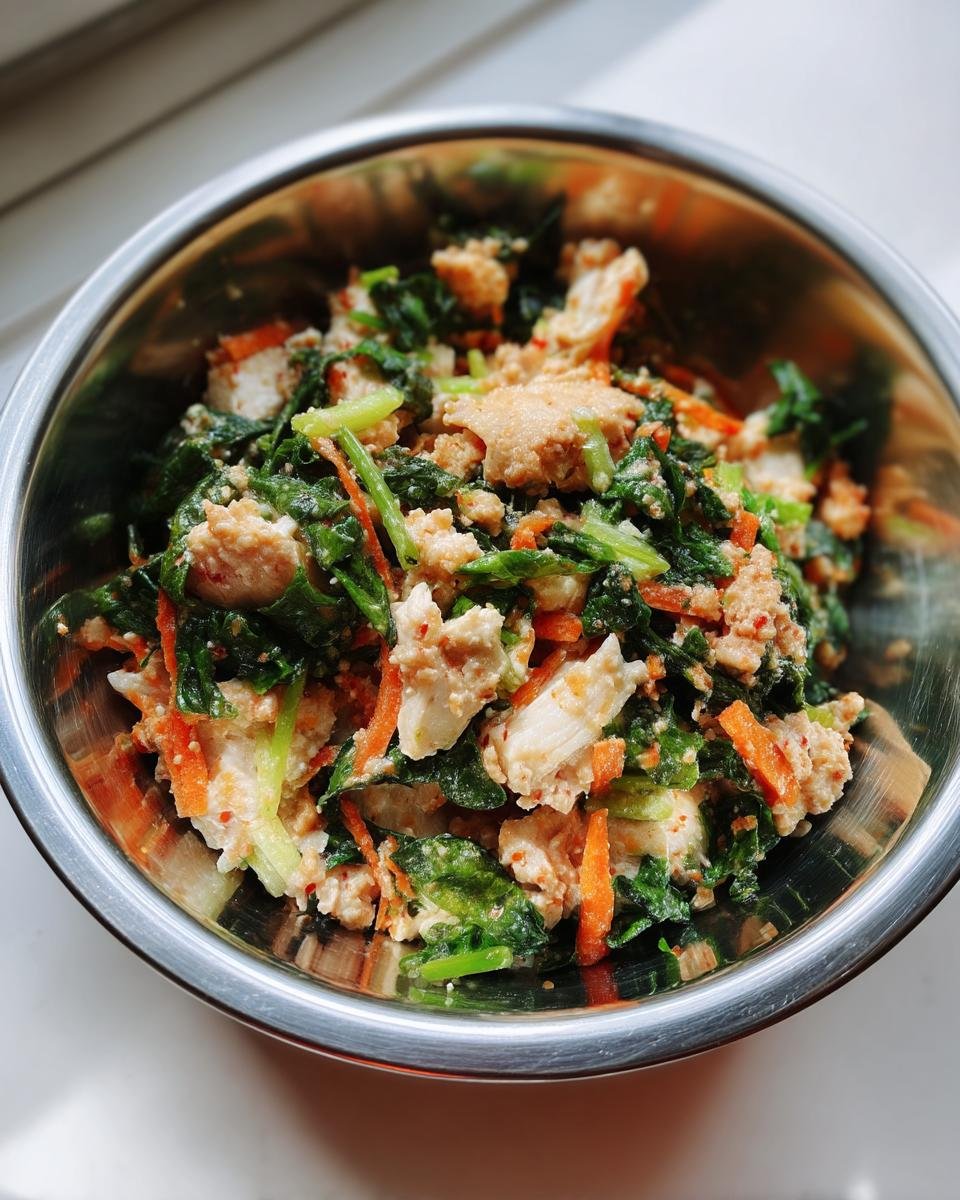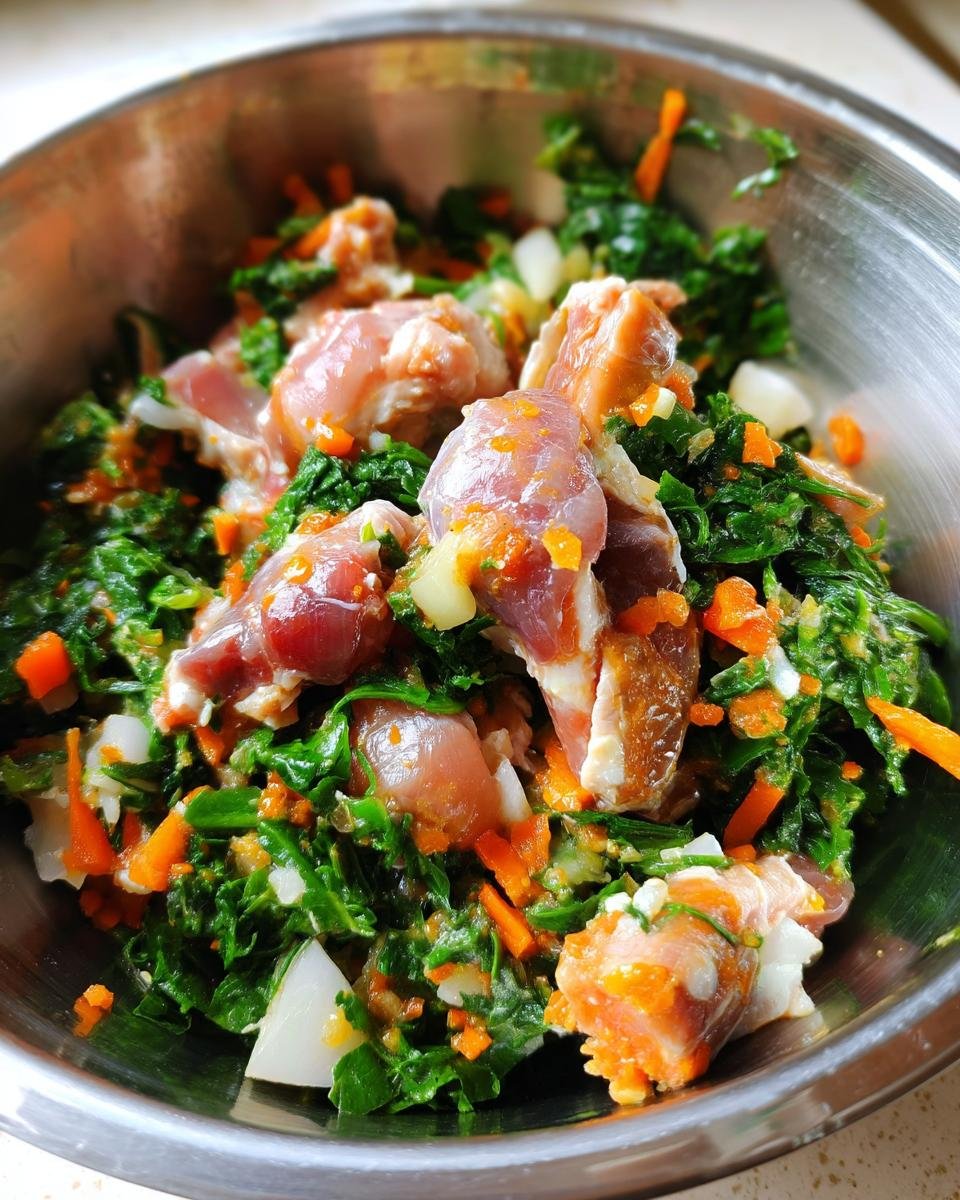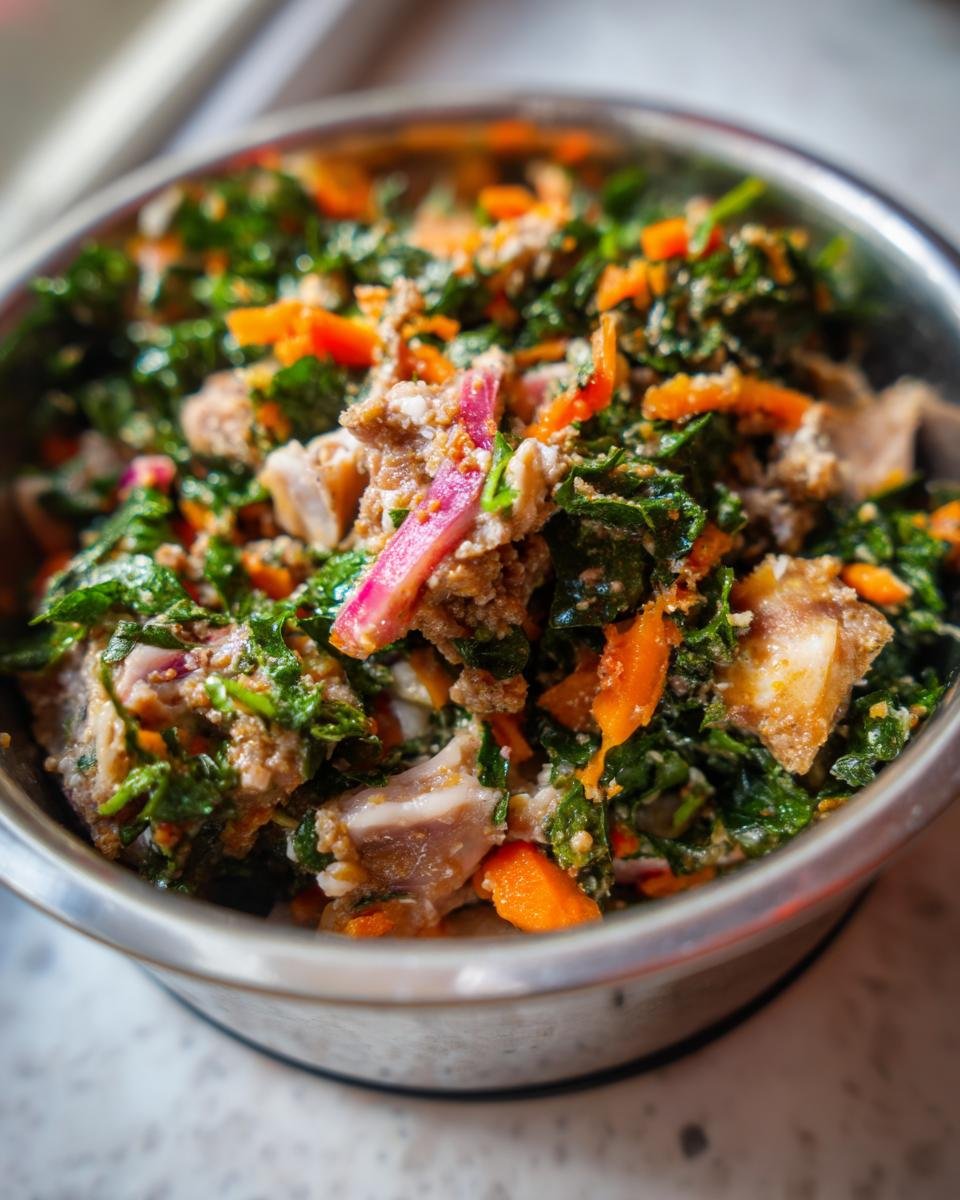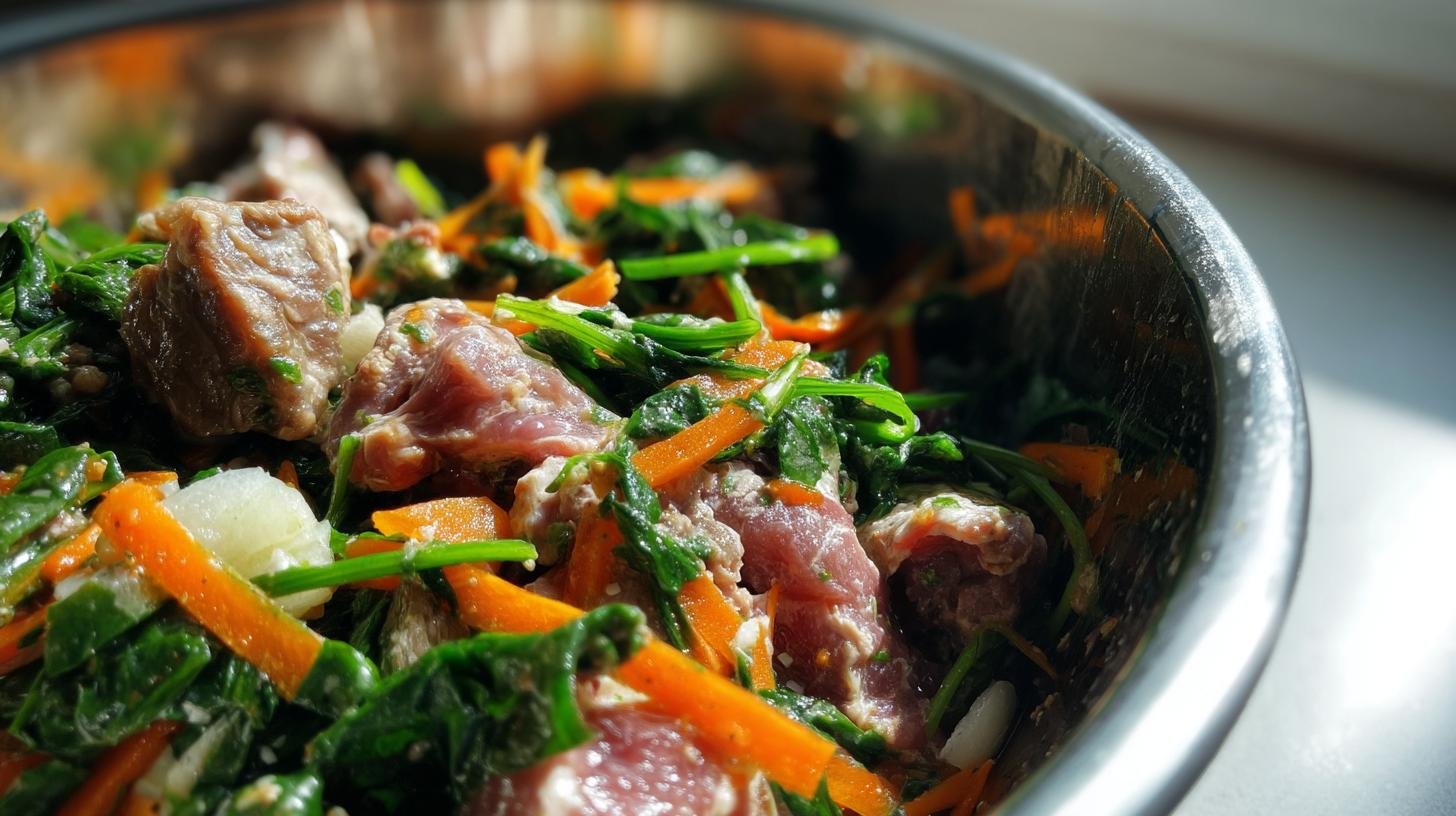Remember when kibble was the only option “good dog parents” bought? I nearly broke my back lugging those 20-pound bags home for Bruno, my perpetually hungry Labrador. Then I noticed his dull coat and that “please don’t make me eat another brown pellet” look. That’s when my neighbor Janine – the one with the Shiba Inu who gleams like a copper penny – introduced me to the BARF diet for beginners.
Switching to raw food felt like learning a new language. I’ll never forget Bruno’s first chicken wing – he stared at it like I’d given him alien technology, then crunched it with a satisfaction that shook the floorboards. But here’s the real tea: transitioning took weeks of failed experiments (“Note to self: zucchini gives dogs gas”), vet consultations, and a very patient butcher.
This guide is what I wish I’d had when garlic breath (mine, from stress-googleging “raw feeding dangers”) filled our kitchen. We’ll cover safe handling, balanced ratios, and the five ingredients that transformed Bruno from sluggish to squirrel-chasing champion. Just promise me one thing – you’ll call your vet before swapping even one kibble? Their stamp of approval matters more than any Pinterest-perfect meal prep.
BARF Diet for Beginners Ingredients List
Let’s talk ingredients – the good, the messy, and the “wait, dogs eat THAT?!” moments. When I first laid out these items on my kitchen counter, my husband thought I’d lost it. But trust me, each piece plays a specific role in keeping your pup thriving. Here’s what you’ll need (and why):

- 500g raw chicken wings (bone-in) – Their natural calcium source. I get mine from a local farmer’s market freezer section
- 300g ground beef – 80/20 fat ratio for energy. Look for bright red meat without that weird supermarket sheen
- 200g beef liver – Vitamin powerhouse! Freeze it for 15 minutes first – trust me, it’s less slippery to handle
- 1 cup chopped spinach (packed) – Roll the leaves like a cigar before slicing. Bruno goes nuts for the texture
- 1/2 cup grated carrots (finely shredded) – Use the small holes on your box grater. No pre-shredded stuff – they’re too dry
- 2 tbsp fish oil (cold-pressed) – The game-changer for shiny coats. Store it in the fridge to prevent rancidity
- 1 whole egg (with crushed shell) – Calcium boost! I dry the shells overnight, then blitz them in my coffee grinder
Food safety note: Keep a dedicated cutting board (mine’s neon green – can’t mix it up!), wash everything in hot soapy water immediately, and for heaven’s sake – no licking your fingers while prepping!
How to Prepare BARF Diet Meals for Beginners
Let’s get messy! The first time I made Bruno’s BARF meal, my kitchen looked like a crime scene – but now I can whip up a week’s worth in 20 minutes flat. Follow these steps closely, and you’ll avoid my early mistakes (like discovering chicken wing shrapnel under the fridge weeks later).

- Chop chicken wings into 1-inch pieces – Use kitchen shears for control. If your dog’s under 30 pounds, cut between the joints. Pro tip: Do this over the bowl to catch flying cartilage bits!
- Grind liver for 30 seconds in food processor – That slimy texture? Totally normal. Pulse until it looks like chunky pâté. No processor? Freeze it slightly and grate like cheese.
- Mix everything but the chicken wings – In your biggest bowl (I use my salad spinner basin!), combine ground beef, liver mush, spinach, carrots, fish oil, and crushed eggshell. Squish with clean hands until it resembles meatloaf mix. Bruno licks the bowl if I let him!
- Portion like a pro – Adult dogs eat 2-3% of their body weight daily. For my 60-pound lab, that’s about 1.5 pounds total. I use a kitchen scale and muffin tins for perfect ½-cup servings.
- Add chicken wings last – Layer 2-3 pieces per container. They’re the “fun” part of the meal! For small dogs, tuck one wing underneath the meat mix to slow down gobblers.
Food safety first: Get those meals into airtight containers and straight into the fridge! I learned the hard way when I left a batch on the counter “just while I cleaned up” – hello, salmonella scare. Use within 3 days or freeze extras. Pro tip: Write dates on lids with dry-erase marker – it saves so many “is this still good?” debates!
Morning prep hack: I make a month’s worth every Sunday while listening to true crime podcasts. Stack frozen portions like meaty hockey pucks – they thaw overnight in the fridge. Watching Bruno crunch into his first homemade meal? Priceless.
Why the BARF Diet for Beginners Works
When Bruno’s coat went from dull to dazzling in three weeks, I became a BARF believer. This isn’t just another diet trend – it’s about working with your dog’s biology. Here’s what makes these messy meals so magical:

- Mimics their ancestral diet: Those chicken wings? They’re nature’s toothbrush and calcium supplement rolled into one. Watching Bruno crunch through bone-in meat, I finally understood – this is what his wolf ancestors ate. The raw beef liver? Pure nutrient density evolution designed for.
- Turns coats into liquid gold: The fish oil in our recipe acts like internal conditioner. After two weeks, Bruno’s fur felt like stroking a seal pup. My groomer actually asked if I’d started giving him salon treatments!
- Happy gut, happy dog: That beef liver isn’t just gross to handle – it’s packed with enzymes that help break down food. Combined with the grated carrots’ fiber, Bruno’s poop firmed up beautifully. No more “I’m sorry, neighbor” backyard cleanups!
Here’s the kicker – rotating proteins weekly (try turkey necks or lamb next!) keeps their system guessing in the best way. My vet calls it “nutritional cross-training.” Bruno just calls it delicious.
Essential Equipment for BARF Diet for Beginners
When I first started BARF prep, my kitchen looked like a mad scientist’s lab – until I realized you really just need four trusty tools. These babies saved me from countless “oops” moments (RIP, favorite wooden spoon that met chicken juice fate).
- Kitchen scale – Non-negotiable. My “eyeballing it” phase led to a very constipated dachshund. Digital scales with tare function? Lifesaver.
- Meat grinder – That liver texture still haunts me. A basic manual one works – just don’t use it for anything else. Pro tip: Freeze the parts first for easier cleaning!
- Stainless steel bowls – Plastic scratches harbor bacteria. My set from the restaurant supply store has survived two years of raw meat battles.
- Freezer containers – Glass? Big nope. Expansion during freezing equals shattered dreams (and glass shards in your salmon patties). I repurpose deli containers – stackable and leak-proof!
Bonus hack: Silicone muffin molds make perfect single-serving portions. Just pop ’em out frozen like meaty cupcakes!
Ingredient Notes for BARF Diet for Beginners
Let’s talk swaps and surprises! When Bruno developed a beef sensitivity last year, I panicked – until our vet taught me the art of substitution. Here’s what I’ve learned about tweaking ingredients without ruining the nutritional balance:

- Beef → Turkey: Perfect for allergy-prone pups. Use dark meat thighs (extra fatty!) and turkey necks instead of chicken wings. Watch out for excited tail wags – turkey’s Bruno’s favorite now.
- Spinach → Kale: My go-to for dogs prone to bladder stones. Kale’s lower in oxalates. Chop it finer than spinach – those curly leaves can cling to teeth like confetti.
- Fish oil → Flaxseed: For pups who turn up their noses at fishy smells. Grind whole flax seeds fresh (they go rancid fast!) and mix into the meat. Not as potent, but better than nothing!
Now, about those eggshells – they’re not just crunch decor. Crushed shells add bioavailable calcium missing in boneless meats. My rookie mistake? Skipping them once. Bruno’s paws started sliding on hardwood floors like he was ice skating – his body was leaching calcium from bones!
Pro tip: Rotate greens weekly – try dandelion greens one week, romaine the next. It keeps meals exciting and covers different nutrients. Just avoid anything from the allium family (no garlic breath for Fido!). Always chat with your vet before major swaps – their input saved Bruno’s bacon (literally, when I tried adding pork without checking!).
Tips for Perfecting the BARF Diet for Beginners
Let’s be real – my first BARF transition looked like a bad science experiment. Bruno’s stomach made sounds worthy of a horror movie soundtrack. These hard-won tips will save you from my early blunders:
- Transition slower than molasses – Mix 25% BARF with 75% kibble for 3 days, then flip the ratio. Full switch by day 10. Rushing this? Cue the “poopocalypse” (you’ve been warned!).
- Rotate proteins like a DJ – Beef week, chicken week, rabbit week. Different meats = balanced nutrients. My calendar alert every Monday: “Switch Bruno’s meat or face the itchies!”
- Become a poop connoisseur – Healthy BARF stools look like firm, crumbly Play-Doh. Too hard? Add pumpkin. Too soft? More bone content. I keep a “poop diary” – weird flex, but vets love it.
Parasite pro tip: Freeze meats for 3+ weeks before using. My chest freezer’s labeled “Bruno’s Buffet” – it nukes any lurking nasties. Bonus? Frozen chicken wings are easier to chop! Just don’t do what I did – thawing a turkey neck in your work bag leads to… interesting conversations.
Last thing: If Fido turns up his nose at liver, don’t panic. Hide it in ground meat like I do – call it “puppy meatloaf.” Works every time!
Storing and Serving BARF Diet for Beginners Meals
Here’s where I nearly failed spectacularly – I once left Bruno’s portion thawing “just for an hour” while I ran errands. Came home to find him licking the counter like a furry crime scene cleaner. Lesson learned: always thaw in the fridge for 24 hours. Use your coldest shelf (not the door!) and keep meals in sealed containers to prevent curious snouts from midnight raids.
Freezing’s your best friend – portioned meals last up to 3 months in airtight containers. I use silicone muffin trays for single servings that pop out like meaty ice cubes. Room-temperature thawing? Big nope. That dangerous “sweating” phase between 40°F-140°F is bacteria’s happy hour. Pro tip: Stick a Post-it on your fridge with thaw dates – “Bruno’s Tuesday dinner” beats guessing games with frosty mystery meat!
Common BARF Diet for Beginners Questions
Is the BARF Diet for Beginners Safe?
Let me tell you straight – raw feeding isn’t risk-free, but neither is that bag of kibble sitting in your pantry. The key? Smart handling. I nearly gave up after my first salmonella scare (note: don’t let your cat “help” with meal prep), but here’s the deal: healthy adult dogs’ stomach acid nukes most bacteria. Puppies and immunocompromised dogs? Different story. Our vet made us wait until Bruno was 6 months old before starting. Always, always work with a vet who understands raw feeding – mine does quarterly stool checks just to be safe.
How Often Should Beginners Feed the BARF Diet?
Depends on your dog’s inner couch potato or athlete! Most adult dogs thrive on one meal daily – Bruno gets his dinner at 5 PM sharp (he’ll stare at the clock like a furry Gordon Ramsay). Puppies need 2-3 smaller meals. For active breeds, our trainer suggested splitting meals before/after exercise to prevent bloat. Pro tip: Use a slow feeder bowl if your dog inhales food – those chicken wings shouldn’t be a speed-eating contest!
Can I Use Frozen Vegetables in BARF Recipes?
Absolutely! Frozen peas and carrots saved me during winter shortages. Flash-frozen veggies often retain more nutrients than “fresh” produce that’s been trucked cross-country. Just thaw and drain thoroughly – nobody wants a soggy meat mix. Avoid anything with added salt or sauces. My hack? Keep frozen spinach ice cubes ready to toss into the grinder. Bruno gets extra excited when I rattle the freezer bag – he thinks it’s veggie confetti time!
Nutritional Considerations for BARF Diet for Beginners
Let’s get real about numbers – that calorie count in our recipe? More of a rough estimate than hard truth. Grass-fed beef has less fat than grain-fed, and organic liver packs way more vitamins. That’s why I email my vet photos of Bruno’s meals monthly. They helped me boost his fish oil when his coat got dull and add zinc supplements when his paws turned crusty. Your dog’s needs shift with age, activity levels, even seasons! Partner with a nutrition-savvy vet for annual blood panels. Remember: These values are your starting line, not the finish. Stay flexible, keep notes, and when in doubt – professional guidance beats Google every time.
Share Your BARF Diet Journey
Nothing makes my day like seeing your pups’ “OMG this is amazing!” face mid-meal. Snap a pic of those messy muzzles and tag @BrunosRawAdventures – we’ll feature our favorites each month. Who knows? Your turkey-neck-obsessed terrier might just inspire someone’s first BARF leap!
Print
BARF Diet for Beginners: 7 Crucial Ingredients for Thriving Pups
- Total Time: 20 minutes
- Yield: 4 servings 1x
- Diet: Low Lactose
Description
The BARF diet (Biologically Appropriate Raw Food) focuses on feeding pets raw, natural ingredients. This beginner-friendly guide helps you prepare balanced meals for your dog using fresh meats, bones, vegetables, and supplements.
Ingredients
- 500g raw chicken wings (with bone)
- 300g ground beef
- 200g beef liver
- 1 cup chopped spinach
- 1/2 cup grated carrots
- 2 tbsp fish oil
- 1 egg (with shell)
Instructions
- Chop chicken wings into bite-sized pieces.
- Grind beef liver in a food processor.
- Mix ground beef, liver, spinach, and carrots in a large bowl.
- Add fish oil and crushed eggshell to the mixture.
- Portion into daily servings based on your dog’s weight.
- Store in airtight containers and freeze unused portions.
Notes
- Consult your vet before starting any new diet
- Wash hands thoroughly after handling raw meat
- Rotate protein sources weekly for balanced nutrition
- Transition gradually over 7-10 days
- Prep Time: 20 minutes
- Cook Time: 0 minutes
- Category: Pet Food
- Method: Raw
- Cuisine: Pet Food
Nutrition
- Serving Size: 1 cup
- Calories: 320
- Sugar: 2g
- Sodium: 90mg
- Fat: 22g
- Saturated Fat: 6g
- Unsaturated Fat: 14g
- Trans Fat: 0g
- Carbohydrates: 5g
- Fiber: 1g
- Protein: 28g
- Cholesterol: 150mg

